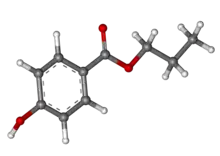Propylparaben
Propylparaben, the n-propyl ester of p-hydroxybenzoic acid, occurs as a natural substance found in many plants and some insects, although it is manufactured synthetically for use in cosmetics, pharmaceuticals, and foods.[1] It is a member of the class of parabens. It is a preservative typically found in many water-based cosmetics, such as creams, lotions, shampoos, and bath products. As a food additive, it has the E number E216.
 | |
 | |
| Names | |
|---|---|
| IUPAC name
Propyl 4-hydroxybenzoate | |
Other names
| |
| Identifiers | |
3D model (JSmol) |
|
| ChEBI | |
| ChEMBL | |
| ChemSpider | |
| ECHA InfoCard | 100.002.098 |
| EC Number |
|
| E number | E216 (preservatives) |
| KEGG | |
PubChem CID |
|
| UNII | |
CompTox Dashboard (EPA) |
|
| |
| |
| Properties | |
| C10H12O3 | |
| Molar mass | 180.203 g·mol−1 |
| Density | 1.0630 g/cm3 |
| Melting point | 96 to 99 °C (205 to 210 °F; 369 to 372 K) |
| Hazards | |
| NFPA 704 (fire diamond) | |
| Related compounds | |
Related compounds |
Paraben Butylparaben Ethylparaben Methylparaben |
Except where otherwise noted, data are given for materials in their standard state (at 25 °C [77 °F], 100 kPa). | |
| Infobox references | |
Sodium propyl p-hydroxybenzoate, the sodium salt of propylparaben, a compound with formula Na(C3H7(C6H4COO)O), is also used similarly as a food additive and as an anti-fungal preservation agent. Its E number is E217.
In 2010 the European Union Scientific Committee on Consumer Safety stated that it considered the use of butylparaben and propylparaben as preservatives in finished cosmetic products as safe to the consumer, as long as the sum of their individual concentrations does not exceed 0.19%.[2]
References
- Oishi (2002). "Effects of propyl paraben on the male reproductive system". Food and Chemical Toxicology. 40 (12): 1807–13. doi:10.1016/s0278-6915(02)00204-1. PMID 12419695.
- Directorate-General for Consumer Safety, European Union (2011). "Scientific Committee on Consumer Safety Opinion on Parabens COLIPA n° P82" (PDF). Retrieved December 15, 2017.
